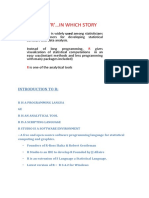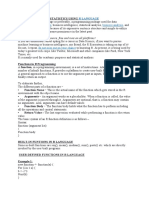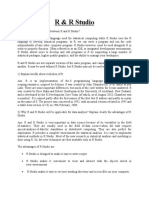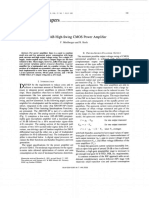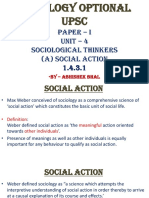Introduction To R: Benny Yakir
Introduction To R: Benny Yakir
Uploaded by
Tom HenCopyright:
Available Formats
Introduction To R: Benny Yakir
Introduction To R: Benny Yakir
Uploaded by
Tom HenOriginal Description:
Original Title
Copyright
Available Formats
Share this document
Did you find this document useful?
Is this content inappropriate?
Copyright:
Available Formats
Introduction To R: Benny Yakir
Introduction To R: Benny Yakir
Uploaded by
Tom HenCopyright:
Available Formats
Introduction to R
Benny Yakir
R is a freely distributed software for data analysis. In order to introduce R let us quote the rst paragraphs from the manual Introduction to R by W. N. Venables, D. M. Smith and the R Development Core Team. (The full document, as well as access to the installation of the software itself, are available online at http://cran.r-project.org/ ): R is an integrated suite of software facilities for data manipulation, calculation and graphical display. Among other things it has an eective data handling and storage facility, a suite of operators for calculations on arrays, in particular matrices, a large, coherent, integrated collection of intermediate tools for data analysis, graphical facilities for data analysis and display either directly at the computer or on hardcopy, and a well developed, simple and eective programming language (called S) which includes conditionals, loops, user dened recursive functions and input and output facilities. (Indeed most of the system supplied functions are themselves written in the S language.) The term environment is intended to characterize it as a fully planned and coherent system, rather than an incremental accretion of very specic and inexible tools, as is frequently the case with other data analysis software. R is very much a vehicle for newly developing methods of interactive data analysis. It has developed rapidly, and has been extended by a large collection of packages. However, most programs written in R are essentially ephemeral, written for a single piece of data analysis. 1
R may be obtained as a source code or installed using a pre-compiled code on the Linux, Mackintosh and the Windows operating systems. Programming in R for this book was carried out under Windows. You may nd more detailed information regarding the installation of R on the Windows operating system at http://www.biostat.jhsph.edu/ kbroman/Rintro/Rwin.html. After installing R under the Windows operating system an icon will be added to the desktop. Double clicking on that icon will open the window of the R system, which contains the R Console sub-window. We found it convenient to have a separate working directory for each project. It is convenient to copy the R icon into that directory and to set the working directory by coping its path (in double quotes) in the appropriate box ("start in:") in the Shortcuts slip of the Properties of the icon (which can be selected by right-clicking the icon.) The R language is an interactive expression-oriented programming langauge. The elementary commands may consist of expressions, which are immediately evaluated, printed to the standard output and lost. Alternatively, expressions can be assigned to object, which store the evaluation of the expression. In the later case the result is not printed out to the screen. These objects are accessible for the duration of the session, and are lost at the end of the session, unless they are actively stored. At the end of the session the user is prompted to store the entire workspace image, including all objects that were created during the session. If Yes is selected then the objects used in the current session will be available in the next. If No is selected then only objects from the last saved image will remain. Commands are separated either by a semi-colon (;), or by a newline. Consider the following example, which we type into the R Console window: > x <- c(1,2,3,4,5,6) > x [1] 1 2 3 4 5 6 Note that in the rst line we created an object named x (a vector of length 6, which stores the value 1 . . . , 6). In the second line we evaluated the expression x, which printed out the actual values stored in x. In the formation of the object x we have applied the c oncatenation function c. This function takes inputs and combine them together to form a vector. Once created, an object can be manipulated in order to create new objects. Dierent operations and functions can applied to the object. The resulting objects, in turn, can be stored with a new name or with the previous name. In the latter case, the content of the object is replaced by the new content. Continue the example: 2
> x*2 [1] 2 4 6 8 10 12 > x [1] 1 2 3 4 5 6 > x <- x*2 > x [1] 2 4 6 8 10 12 Observe that the original content of x was not changed due to the multiplication by two. The change took place only when we deliberately assigned new values to the object x. Say we want to compute the average of the vector x. The function mean can be applied to produce: > mean(x) [1] 7 A more complex issue is to compute the average of a subset of x, say the values larger than 6. Selection of a sub-vector can be conducted by use of the vector index, which is accessible by the use of square brackets next to the object. Indexing can be implemented in several ways, including the standard indexing of a sequence using integers. An alternative method of indexing, which is natural in many applications, is via a vector with logical TRUE/FALSE components. Consider the following example: > x > 6 [1] FALSE FALSE FALSE > x[x > 6] [1] 8 10 12 > mean(x[x > 6]) [1] 10 TRUE TRUE TRUE
Observe that the vector x > 6 is a logical vector of the same length as the vector x. Only the components of x parallel to the components with a TRUE value in the logical indexing vector are selected. In the last line of the example the resulting object is used as the input to the function mean, which produces the expected value of 10. For comparison consider a dierent example: > x*(x > 6) [1] 0 0 0 8 10 12 > mean(x*(x >6)) [1] 5 3
In this example we multiplied a vector of integers x with a vector of logical values (x > 6). The result was a vector of length 6 with zero components where the logical vector takes the value FALSE and the original values of x where the logical value takes the value TRUE. Two points should be noted. First, observe that R can interpret a product of a vector with integer components and a vector with logical components in a reasonable way. Standard programming languages may have produced error messages in such a circumstance. In this case, R translates the logical vector into a vector with integer values one for TRUE and zero for FALSE. The outcome, a product of two vectors with integer components, is a vector of the same type. The second point to make is that multiplication of two vectors is conducted term by term. It is not the inner product between vectors. A dierent operator is used in R in order to preform inner products. Next let us try to program in R functions that simulate the processes meiosis and mating. Imagine a given locus on a given chromosome with two possible variate forms (alleles ). One is denoted by A and the other by a. We have in mind aa animal, say a laboratory mouse, that produces gametes. Assume that the paternal allele of the mouse is A and the maternal allele is a. > n <- 9 > pat <- rep("A",n) > mat <- rep("a",n) > pat [1] "A" "A" "A" "A" "A" "A" "A" "A" "A" > mat [1] "a" "a" "a" "a" "a" "a" "a" "a" "a" > mode(pat) [1] "character" Observe that pat and mat are vectors of character strings. They are of length 9. The function rep is useful to produce repetitions of patterns. Combining it with the function seq, that forms regular sequences is useful at times. The gametes that are produced by the process of meiosis may be of either of the types at the given locus. According to Mendels rst law of segregation, the probabilities of the two types are even: > from.mat <- rbinom(n,1,0.5) > offspring <- pat > from.mat==1 [1] TRUE TRUE FALSE TRUE TRUE 4
TRUE
TRUE FALSE
TRUE
> offspring[from.mat==1] [1] "A" "A" "A" "A" "A" "A" > mat[from.mat==1] [1] "a" "a" "a" "a" "a" "a" > offspring[from.mat==1] <> offspring [1] "a" "a" "A" "a" "a" "a" > 2:6 [1] 2 3 4 5 6 > offspring[2:6] [1] "a" "A" "a" "a" "a" > offspring[-(2:6)] [1] "a" "a" "A" "a"
"A" "a" mat[from.mat==1] "a" "A" "a"
In the nal part of this demonstration we use integers to index components of the vector. The minus sign is used in order to identify the indices we would like to exclude. It would be convenient to wrap the code that produces random gametes in a function. R functions produced with the aid of the function function. The arguments of the produced function are identied in the brackets. The function evaluates the expression that follows. Composite expressions can be combined together by placing them within curly brackets. The output of the function may be specied with the function return. Otherwise, the function returns the evaluation of the expression. > meiosis <- function(GF,GM) + { + from.GM <- rbinom(length(GF),1,0.5) + GS <- GF + GS[from.GM==1] <- GM[from.GM==1] + return(GS) + } > meiosis(pat,mat) [1] "A" "a" "a" "a" "A" "a" "A" "a" "A" The the process of mating a father mouse is donating its gametes (sperm) to the mother. These gametes merge with the mothers gametes (eggs) to produce the osprings. > male <- list(pat=rep("A",n),mat=rep("a",n)) > female <- list(pat=rep("a",n),mat=rep("a",n)) 5
We consider a father, which is heterozygote at the given locus and a mother, which is homozygote at that locus. An animal is represented by a list, which contains the two grand-parental alleles. List in R are a special type of vector. Each entry to a vector of type list can store any type of object, regardless of the type of objects in the other entries. Here each entry stores a vector. The entries in this example are given names, which can then be used in order to refer to the entry. We demonstrate that using the function cross, which simulates the formation of ospring by crossing a mother mouse with father mouse: > cross <- function(fa,mo) + { + pat <- meiosis(fa$pat,fa$mat) + mat <- meiosis(mo$pat,mo$mat) + return(list(pat=pat, mat=mat)) + } Running the function produces: > cross(male,female) $pat [1] "A" "a" "a" "A" "A" "a" "a" "A" "A" $mat [1] "a" "a" "a" "a" "a" "a" "a" "a" "a"
You might also like
- Probability Theory - VaradhanDocument6 pagesProbability Theory - VaradhanTom Hen100% (1)
- A Detailed Lesson Plan in ScienceDocument4 pagesA Detailed Lesson Plan in Sciencemarigold100% (3)
- Intercomp PT20 Instruction ManualDocument39 pagesIntercomp PT20 Instruction ManualCloudkarl DesalesNo ratings yet
- Geometric Sequence: Salary Scheme: 42,000 and Its Range Is Good For 2 Years, WithDocument9 pagesGeometric Sequence: Salary Scheme: 42,000 and Its Range Is Good For 2 Years, Withmk50% (4)
- HRM 325Document2 pagesHRM 325Asif Islam0% (1)
- Introduction To R Installation: Data Types Value ExamplesDocument9 pagesIntroduction To R Installation: Data Types Value ExamplesDenis ShpekaNo ratings yet
- Stat3355 PDFDocument106 pagesStat3355 PDFAfaq SaleemNo ratings yet
- Background: 1.1 General IntroductionDocument19 pagesBackground: 1.1 General IntroductiondimtryNo ratings yet
- UntitledDocument59 pagesUntitledSylvin GopayNo ratings yet
- MTH5120 Statistical Modelling I Tutorial 1Document3 pagesMTH5120 Statistical Modelling I Tutorial 1lassti hmNo ratings yet
- R StudioDocument41 pagesR StudioEmre CanNo ratings yet
- STATS LAB Basics of R PDFDocument77 pagesSTATS LAB Basics of R PDFAnanthu SajithNo ratings yet
- Introduction To RDocument20 pagesIntroduction To Rseptian_bbyNo ratings yet
- R InterviewDocument20 pagesR InterviewVishal ShahNo ratings yet
- R AdvancedDocument4 pagesR AdvancedgideonengmannNo ratings yet
- A Report On R Name-Kaveena ROLL NO-12EE46Document10 pagesA Report On R Name-Kaveena ROLL NO-12EE46Rishabh JindalNo ratings yet
- PW1 2Document20 pagesPW1 2Наталья ДолговаNo ratings yet
- ALL-FAQ-R LanguageDocument161 pagesALL-FAQ-R LanguageUmamaheswaraRao PutrevuNo ratings yet
- Bayesian AnswersDocument13 pagesBayesian AnswersDorin KatuuNo ratings yet
- R Basics: Installing RDocument9 pagesR Basics: Installing RAhmad AlsharefNo ratings yet
- R Module 1Document34 pagesR Module 1NIDHISH SNo ratings yet
- Introduction To R: General LinesDocument36 pagesIntroduction To R: General LinesshaimaaNo ratings yet
- Module 1-1Document38 pagesModule 1-1Aakash RajputNo ratings yet
- R Programming Paper SolutionsDocument43 pagesR Programming Paper Solutionsjayvaghela1542No ratings yet
- R - Interview QuestionsDocument7 pagesR - Interview QuestionsRakshit VajaNo ratings yet
- R IntroductionDocument40 pagesR IntroductionSEbastian CardozoNo ratings yet
- Teaching Notes of RDocument78 pagesTeaching Notes of RamritaNo ratings yet
- Me-I 2022 - ML LabDocument28 pagesMe-I 2022 - ML Labroshni mohan kumarNo ratings yet
- Introduction To RDocument36 pagesIntroduction To RYared FikaduNo ratings yet
- E5 - Statistical Analysis Using RDocument45 pagesE5 - Statistical Analysis Using RAhmed Ashraf100% (1)
- R LecturesDocument10 pagesR LecturesApam BenjaminNo ratings yet
- Introduction To R: Nihan Acar-Denizli, Pau FonsecaDocument50 pagesIntroduction To R: Nihan Acar-Denizli, Pau FonsecaasaksjaksNo ratings yet
- MultivariateRGGobi PDFDocument60 pagesMultivariateRGGobi PDFDiogo BarriosNo ratings yet
- Data Analysis2Document16 pagesData Analysis2rohit972012No ratings yet
- Structs Impl PRG LanDocument11 pagesStructs Impl PRG LanGoogle DocNo ratings yet
- R-Programming: To See The Working Directory in R StudioDocument17 pagesR-Programming: To See The Working Directory in R StudioNonameforeverNo ratings yet
- Dzone R RefcardDocument9 pagesDzone R Refcardclungaho7109No ratings yet
- R NotesDocument27 pagesR NotesFATIMA DEGREE COLLEGE HubliNo ratings yet
- R Programming SwirlDocument22 pagesR Programming SwirlRobin PhilipNo ratings yet
- AI Lecture 4 PracticalDocument15 pagesAI Lecture 4 PracticalJegr SardarNo ratings yet
- Unit - 1 Q) What Is R Programming? What Are The Features of R Programming?Document32 pagesUnit - 1 Q) What Is R Programming? What Are The Features of R Programming?1951 04 Ajay Kadaru II IOTNo ratings yet
- Statistics Using R LanguageDocument5 pagesStatistics Using R LanguageTanishqa RawlaniNo ratings yet
- LAB1Document12 pagesLAB1Mohan KishoreNo ratings yet
- R Short TutorialDocument5 pagesR Short TutorialPratiush TyagiNo ratings yet
- 4 - DataTypes Vector Matrices OperatorsDocument33 pages4 - DataTypes Vector Matrices OperatorsAnurag SharmaNo ratings yet
- R Language Lab Manual Lab 1Document33 pagesR Language Lab Manual Lab 1spikeisgreen100% (1)
- AnovaDocument150 pagesAnovaalexleg26No ratings yet
- Descriptive and Inferential Statistics With RDocument6 pagesDescriptive and Inferential Statistics With RTrần Thị Bích Thảo 3KT -19No ratings yet
- Muthulakshmi M: Software Technical Trainer IBMDocument81 pagesMuthulakshmi M: Software Technical Trainer IBMNarenkumar. NNo ratings yet
- Mathematical Computations Using RDocument53 pagesMathematical Computations Using RRishi RanjanNo ratings yet
- R ProgrammingDocument48 pagesR ProgrammingMeghana BaradNo ratings yet
- What Is Recursive Programming in Python?Document4 pagesWhat Is Recursive Programming in Python?Paul WahomeNo ratings yet
- R LanaguageDocument25 pagesR LanaguagearyanNo ratings yet
- R Tutorial Ie255Document26 pagesR Tutorial Ie255Roosevelt BaşkanNo ratings yet
- R - Chapter 1Document11 pagesR - Chapter 1Akshay HebbarNo ratings yet
- R-Unit 5Document76 pagesR-Unit 5Lakshmi GaneshNo ratings yet
- Introduction To RDocument6 pagesIntroduction To RMehrdad MohammadiNo ratings yet
- Data Types in R ProgrammingDocument9 pagesData Types in R ProgrammingAmisha SharmaNo ratings yet
- Data Analysis Using R - 2Document23 pagesData Analysis Using R - 2harshvasudevkoliNo ratings yet
- R and R StudioDocument10 pagesR and R StudioTeetas SahaNo ratings yet
- Logistic MapDocument8 pagesLogistic MapSathya ArulNo ratings yet
- R Module 1 NotesDocument15 pagesR Module 1 NotesmagnawamelaniejaneNo ratings yet
- Normal Distribution Characterizations With ApplicationsDocument132 pagesNormal Distribution Characterizations With ApplicationsTom HenNo ratings yet
- MITPress - SemiSupervised Learning PDFDocument524 pagesMITPress - SemiSupervised Learning PDFTom HenNo ratings yet
- RintroDocument14 pagesRintroTom HenNo ratings yet
- Instructions SC EX365 2021 2aDocument4 pagesInstructions SC EX365 2021 2aChandilNo ratings yet
- DV-PME Letter VS JE 201222Document2 pagesDV-PME Letter VS JE 201222RIDDHI SINGHNo ratings yet
- Data Visualization - What Does An Added Variable Plot (Partial Regression Plot) Explain in A MultiplDocument1 pageData Visualization - What Does An Added Variable Plot (Partial Regression Plot) Explain in A MultiplvaskoreNo ratings yet
- Testimony of Victor MartinezDocument1 pageTestimony of Victor MartinezcrystleagleNo ratings yet
- Drill 1Document40 pagesDrill 1Hanz Luis Anzano0% (1)
- Hino 700 Power SteeringDocument56 pagesHino 700 Power SteeringJoki Marzuki100% (3)
- SOW ENGLISH YEAR 6 2023-2024 by RozayusAcademyDocument13 pagesSOW ENGLISH YEAR 6 2023-2024 by RozayusAcademyRoziyanah SanipNo ratings yet
- SKF Manual de ApertosDocument44 pagesSKF Manual de ApertosA RNo ratings yet
- Nephrotic Syndrome in ChildrenDocument12 pagesNephrotic Syndrome in ChildrenLaras Ciingu Syahreza0% (1)
- Applications and Interpretation Higher November 2021 Paper 1Document28 pagesApplications and Interpretation Higher November 2021 Paper 1sachinNo ratings yet
- Respronics V60 Ventilator - Service ManualDocument246 pagesRespronics V60 Ventilator - Service ManualEduardoNo ratings yet
- Anders Chan - Dissertation 04-08-2024 FinalDocument83 pagesAnders Chan - Dissertation 04-08-2024 Finalanders.chanNo ratings yet
- Fosroc Nitobond AR - MSDSDocument4 pagesFosroc Nitobond AR - MSDSSantos RexNo ratings yet
- Fndmath ReviewerDocument2 pagesFndmath ReviewerRocelle Andrea BelandresNo ratings yet
- Squad Manual Vol 1 1 PDFDocument224 pagesSquad Manual Vol 1 1 PDFSharaS.YbañezNo ratings yet
- High Swing Power AmplifierDocument4 pagesHigh Swing Power AmplifierSyed AfzalNo ratings yet
- Lesson Plan in Numeracy Kindergarten (Count To Four)Document3 pagesLesson Plan in Numeracy Kindergarten (Count To Four)Charity100% (1)
- Anhedonia and Suicidal Thoughts and Behaviors in Psychiatric OutpatientsDocument11 pagesAnhedonia and Suicidal Thoughts and Behaviors in Psychiatric OutpatientsstrillenNo ratings yet
- Present Perfect For ExperienceDocument3 pagesPresent Perfect For ExperienceLeonardo MonteiroNo ratings yet
- The Self As A Cognitive ConstructionDocument14 pagesThe Self As A Cognitive ConstructionArian Jean DiamanteNo ratings yet
- A Virtual Private Network (VPN) Infrastructure For Philippine Military Academy (Pma) and GeneralDocument3 pagesA Virtual Private Network (VPN) Infrastructure For Philippine Military Academy (Pma) and GeneralMuhammad IfdhalNo ratings yet
- RSL MCQ TestDocument17 pagesRSL MCQ TestShivamNo ratings yet
- Introduction To Automata TheoryDocument4 pagesIntroduction To Automata TheoryAnand Babu0% (2)
- 1.4.3.1 Social Action PDFDocument9 pages1.4.3.1 Social Action PDFAnonymous gf2aAKNo ratings yet
- Case Study On Stress Management PDFDocument8 pagesCase Study On Stress Management PDFRíshãbh JåíñNo ratings yet
- Microsoft Word - Styles and Themes Lesson PlanDocument6 pagesMicrosoft Word - Styles and Themes Lesson PlanCezar Jhon Gelua UrbanoNo ratings yet








